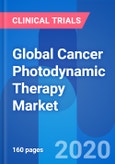Global Cancer Photodynamic Therapy Market & Photosensitizer Clinical Trial Outlook 2030 Report Highlights:
- Research Methodology
- Overview On Procedural Framework For Photodynamic Cancer Therapy
- Global Cancer Photodynamic Therapy Market Opportunity: > USD 6 Billion
- Global & Regional Market Trends Insight,
- Integration Of Photodynamic Therapy By Indication
- Insight On Cancer Photosensitizers In Clinical Trials: > 10
- Global Photosensitizers Clinical Pipeline By Company, Indication & Phase
- Insight On Key Approaches For Tumor Eradication Through Synergistic Photodynamic Therapy
- Competitive Landscape
Need for Photodynamic Therapy & Why This Report?
Photodynamic therapy (PDT) is becoming a valuable alternative and adjunct to traditional cancer therapies because of its novel mechanism of action and strongly localized effects. Photodynamic therapy uses a triad of agents, namely photosensitizing drugs, light of a specific wavelength, and tissue-bound oxygen, to produce cytotoxic reactive oxygen species that selectively destroy cancer cells. Such a mechanism provides site-specific tumor killing with minimal damage to neighboring healthy tissues, a major advantage over chemotherapy and radiotherapy, which tend to cause systemic toxicity or collateral tissue destruction.
The requirement for photodynamic therapy has been particularly apparent in the treatment of cancers in cosmetically and functionally critical areas, including the skin, esophagus, lung, and cervix. The potential to re-administer photodynamic therapy several times without cumulative toxicity further increases its importance in the management of recurrent or unresectable tumors. Additionally, photodynamic therapy ability to induce localized immune responses and maintain organ function adds to its increasing popularity among medical specialties.
This report has been created to deliver an extensive overview of photodynamic therapy as a dynamic therapeutic strategy. It encapsulates the technology’s mechanistic advantages, indications approved by regulatory agencies, problems, and current innovations, making it a high-potential solution for both oncology and non-oncology practices.
Clinical Trials Insight Included In Report
Photodynamic therapy has been subjected to strenuous clinical investigations in multiple tumors and stages of disease. A number of photosensitizers have already gained regulatory approval for individual indications following the successful completion of Phase III trials. Porfimer sodium (Photofrin), the first commercially available photodynamic therapy agent, was shown to be effective in esophageal carcinoma, non-small cell lung carcinoma, and pre-cancerous lesions such as Barrett’s esophagus. Aminolevulinic acid (ALA) and its analogue MAL are approved for actinic keratosis and superficial basal cell carcinoma following dermatological trials, which achieved excellent lesion removal with little cosmetic damage.
More recent agents such as temoporfin are also being further tested for head and neck cancers. Photodynamic therapy is also being examined through multiple Phase II and III studies for gliomas, cholangiocarcinoma, and intraocular tumors, frequently in populations with few other treatment options. The report includes information on the design and results of these trials, including variables of photosensitizer type, techniques of light delivery, oxygenation status, and patient-reported outcomes.
Moreover, early-stage clinical trials are assessing photodynamic therapy in combination with immunotherapy or chemotherapy to improve therapeutic outcomes and overcome tumor resistance. These combinatorial strategies are gaining traction as they seek to integrate photodynamic therapy localized effect with systemic immune activation or cytotoxic synergy.
Key Companies Involved In R&D Of Photodynamic Therapies
Various biotech and pharmaceutical firms, as well as academic institutions, are engaged in developing and optimizing photodynamic therapy platforms. Industry leaders like Pinnacle Biologics, Biofrontera, Soligenix, and Steba Biotech are working on next-generation photosensitizers with enhanced pharmacokinetics, reduced photosensitivity times, and greater tumor specificity. Biofrontera, for instance, has marketed several ALA-based photodynamic therapy products for dermatological applications in the US and EU.
Academic institutions such as Roswell Park Comprehensive Cancer Center, University College London, and Harvard Medical School play a critical role in creating new light delivery systems and investigating photodynamic therapy -induced immune mechanisms. Their investigations are the foundation of current collaborations and clinical partnerships that seek to extend photodynamic therapy into new oncologic and non-oncologic frontiers.
Concurrently, technology ventures are using nanotechnology and drug design supported by artificial intelligence to develop intelligent delivery systems that enhance photosensitizer targeting and minimize off-target effects. These developments are enhancing the extent of applications and safety profile of photodynamic therapy treatments.
Report Highlighting Future Direction Of Photodynamic Therapy Segment
Even though it has proven therapeutic importance, photodynamic therapy is still being developed through scientific and technological innovation. The future stage of development addresses current shortcomings: essentially light penetration depth, oxygen dependency, and long-term photosensitivity. To suppress them, researchers are engineering near-infrared activatable photosensitizers, tumor-targeted nanoparticles, and oxygen independent reaction mechanisms.
One promising area of future development involves the combination of photodynamic therapy with immunotherapies, including checkpoint inhibitors. Photodynamic therapy capacity for the delivery of tumor associated antigens as well as the induction of immunogenic cell death makes it a perfect companion to therapies enhancing the immune system’s potential for cancer fighting. This combination is being explored in several preclinical models as well as early-phase clinical trials.
In addition, the incorporation of nanocarrier based delivery systems will be able to enhance the pharmacological profile of photosensitizers, facilitating specific tumor targeting and controlled activation. Interest also exists in the application of photodynamic therapy for non-oncology indications like antimicrobial therapy, age related macular degeneration, and even autoimmune skin diseases, illustrating its wider therapeutic promise.
This report details these future directions, providing insights into new photosensitizer design, emerging clinical approaches, and spaces where photodynamic therapy can take hold beyond its established indications. For oncology, dermatology, biotechnology, and healthcare policy stakeholders, the photodynamic therapy segment is an expanding frontier that intersects with precision medicine and organ-sparing treatment objectives.
Table of Contents
1. Research Methodology
Companies Mentioned (Partial List)
A selection of companies mentioned in this report includes, but is not limited to:
- Asieris Pharmaceuticals
- Aura Biosciences
- Biofrontera AG
- Biolitec
- Coherent
- Galderma
- Hemerion Therapeutics
- ImPact Biotech
- Invion
- Luzitin
- Modulight Corporation
- Molteni Farmaceutici
- PCI Biotech
- PhotoBiotics
- Photolitec
- photonamic
- Pinnacle Biologics
- Rakuten Medical
- Theralase Technologies
- SBI Pharmaceuticals
- Shanghai Fudan-Zhangjiang Bio-Pharmaceutical
- Soligenix
- Sun Pharma








